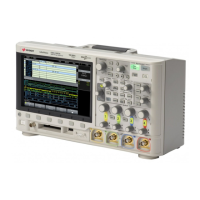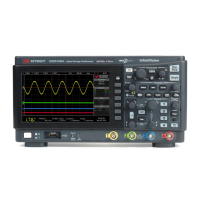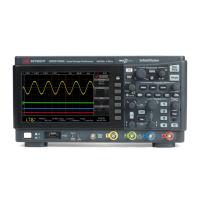SENT Triggering and Serial Decode 32
Keysight InfiniiVision 3000T X-Series Oscilloscopes User's Guide 503
• Successive Sync Pulses Error — triggers on a sync pulse whose width varies
from the previous sync pulse's width by greater than 1/64 (1.5625%, as
defined in the SENT specification).
4 If you choose the Fast Channel SC & Data trigger condition:
a Press the Base softkey to choose between Hex or Binary data value entry.
Use the Binary method if you need to enter "don't care" bits (X) within a
nibble. If all bits in a nibble are "don't care", the hex nibble is displayed as
"don't care" (X). When all bits in a nibble are 1s or 0s, the hex value is shown.
Hex nibbles that contain a mix of 0/1 bits and "don't care" bits are displayed
as "$".
b Press the SC & Data softkey and use the keypad dialog to enter the data
value.
The S&C nibble is the left most nibble entered in the string of numbers,
followed by the data nibbles.
5 If you choose the Slow Channel Message ID or Slow Channel Message ID & Data
trigger condition:
a Press the Configuration softkey to select the desired packet ID for the selected
packet type.
When an Enhanced Serial message format is specified (see “Setup for SENT
Signals" on page 497), press this softkey to select which enhanced format
configuration is being used:
• 16-Bit Data, 4-Bit ID
• 12-Bit Data, 8-Bit ID
b Press the Slow Message ID softkey and use the Entry knob (or press the
softkey again and use a keypad dialog) to specify the Slow Message ID.
c If you choose the Slow Channel Message ID & Data trigger condition, press the
Slow Data softkey and use the Entry knob (or press the softkey again and use
a keypad dialog) to specify the Slow Message data.
6 If you choose the Tolerance Violation trigger condition, press the Tolerance
softkey and use the Entry knob (or press the softkey again and use a keypad
dialog) to specify the tolerance variation that is considered a violation.
The percentage entered must be less than the percent tolerance specified in
the decode bus configuration settings.
